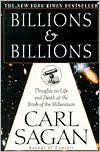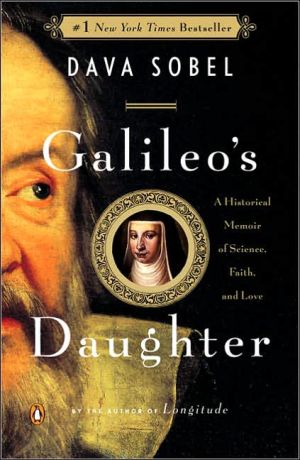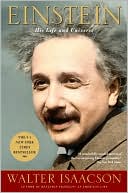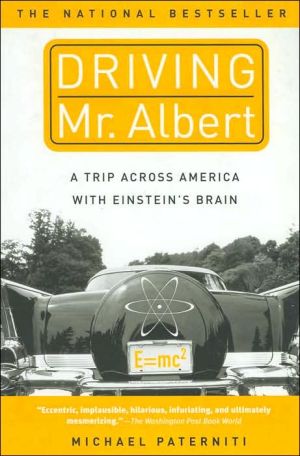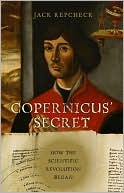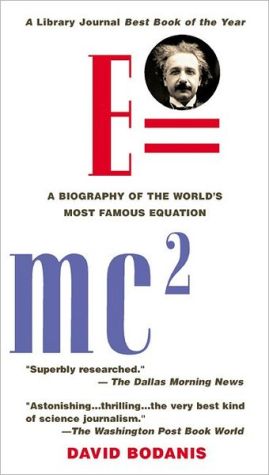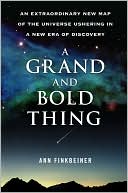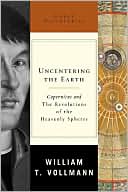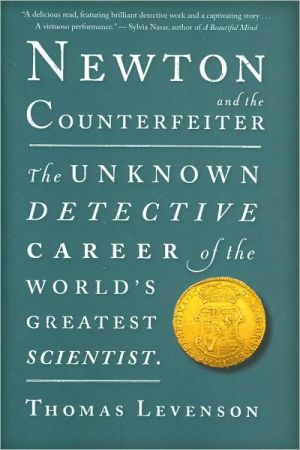Billions and Billions: Thoughts on Life and Death at the Brink of the Millennium
In the final book of his astonishing career, Carl Sagan brilliantly examines the burning questions of our lives, our world, and the universe around us. These luminous, entertaining essays travel both the vastness of the cosmos and the intimacy of the human mind, posing such fascinating questions as how did the universe originate and how will it end, and how can we meld science and compassion to meet the challenges of the coming century? Here, too, is a rare, private glimpse of Sagan's...
Search in google:
In the final book of his astonishing career, Carl Sagan brilliantly examines the burning questions of our lives, our world, and the universe around us. These luminous, entertaining essays travel both the vastness of the cosmos and the intimacy of the human mind, posing such fascinating questions as how did the universe originate and how will it end, and how can we meld science and compassion to meet the challenges of the coming century? Here, too, is a rare, private glimpse of Sagan's thoughts about love, death, and God as he struggled with fatal disease. Ever forward-looking and vibrant with the sparkle of his unquenchable curiosity, Billions & Billions is a testament to one of the great scientific minds of our day. Publishers Weekly In a book completed less than two months before his death, Sagan (The Demon-Haunted World, etc.) compels his readers to look at life. Although many of the essays here have appeared previously, they gain power through juxtaposition and new commentary. They portray humankind as a favored species on a fragile world, facing the profound impact that 20th-century technology will have on its future. Six essays on "The Power of Beauty of Quantification" celebrate science and the insights it gives us into the cosmos, our planet and our species. Seven more, exploring the question "What are Conservatives Conserving?," discuss the political and economic factors that have led to quite different international responses to two environmental threats: the "ozone hole" and global warming. These pieces culminate with a joint appeal from scientific and religious leaders committed to saving the planet. The interplay among scientific, religious and political thought continues in the closing set of six essays, "Where Hearts and Minds Collide." Here, Sagan prompts readers to look beyond their own lives and to the preservation of our species and our world. As the author's widow, Ann Druyan, writes in her epilogue, "For Carl, what mattered most was what was true, not merely what would make us feel better. Even at [the moment of death] when anyone would be forgiven from turning away from the reality of the situation, Carl was unflinching." So should we be, says this book; the life of our species on our delicately balanced planet depends on it.
Epilogue\ \ With characteristic optimism in the face of harrowing ambiguity, Carl writes the final entry in a prodigious, passionate, daringly transdisciplinary, and astonishingly original body of work.\ \ Mere weeks later, in early December, he sat at our dinner table, regarding a favorite meal with a look of puzzlement. It held no appeal. In the best of times, my family had always prided itself on what we call wodar, an inner mechanism that ceaselessly scans the horizon for the first blips of looming disaster. During our two years in the valley of the shadow, our wodar had remained at a constant state of highest alert. On this roller coaster of hopes dashed, raised, and dashed again, even the slightest variation in a single particular of Carl's physical condition would set alarm bells blaring.\ \ A beat of a look passed between us. I immediately began spinning a benign hypothesis to explain away this sudden lack of appetite. As usual I was arguing that this might have nothing to do with his illness. It was merely a fleeting disinterest in food that a healthy person might not even notice. Carl managed a little smile and just said, Maybe. But from that moment on he had to force himself to eat and his strength declined noticeably. Despite this, he insisted on fulfilling a long-standing commitment to give two public lectures later that week in the San Francisco Bay area. When he returned to our hotel after the second talk, he was exhausted. We called Seattle.\ \ The doctors urged us to come back to the Hutch immediately. I dreaded having to tell Sasha and Sam that we would not be returning home to them the next day as promised; that instead we would be making yet afourth trip to Seattle, a place that had become to us synonymous with dread. The kids were stunned. How could we convincingly calm their fears that this might turn out, as it had three times before, to be another six-month stint away from home or, as Sasha immediately suspected, something far worse? Once again I went into my cheerleading mantra: Daddy wants to live. He's the bravest, toughest man I know. The doctors are the best the world has to offer ... Yes, Hanukkah would have to be postponed. But once Daddy was better ...\ \ The next day in Seattle, an X-ray revealed that Carl had a pneumonia of unknown origin. Repeated tests failed to turn up any evidence for a bacterial, viral, or fungal culprit. The inflammation in his lungs was, perhaps, a delayed reaction to the lethal dose of radiation that he had received six months before as preparation for the last bone marrow transplant. Megadoses of steroids only compounded his suffering and failed to repair his lungs. The doctors began to prepare me for the worst. Now, when I ventured out into the hospital hallway, I encountered a whole different species of expression on the too familiar faces of the staff. They either winced with sympathy or averted their eyes. It was time for the kids to come west.\ \ When Carl saw Sasha it seemed to effect a miraculous change in his condition. Beautiful, beautiful, Sasha, he called to her. You are not only beautiful, but you also have enormous gorgeousness. He told her that if he did manage to survive it would be in part because of the strength her presence had given him. And for the next several hours the hospital monitors seemed to document a turnaround. My hopes soared, but in the back of my mind I couldn't help notice that the doctors didn't share my enthusiasm. They recognized this momentary rallying for what it was, what they call an Indian summer, the body's brief respite before its final struggle.\ \ This is a deathwatch, Carl told me calmly. I'm going to die. No, I protested. You're going to beat this, just as you have before when it looked hopeless. He turned to me with that same look I had seen countless times in the debates and skirmishes of our twenty years of writing together and being wildly in love. With a mixture of knowing good humor and skepticism, but as ever, not a trace of self-pity, he said wryly, Well, we'll see who's right about this one.\ \ Sam, now five years old, came to see his father for one last time. Although Carl was by now struggling for breath and finding it harder to speak, he managed to compose himself so as not to frighten his little son. I love you, Sam, was all he could say. I love you, too, Daddy, Sam said solemnly.\ \ Contrary to the fantasies of the fundamentalists, there was no deathbed conversion, no last minute refuge taken in a comforting vision of a heaven or an afterlife. For Carl, what mattered most was what was true, not merely what would make us feel better. Even at this moment when anyone would be forgiven for turning away from the reality of our situation, Carl was unflinching. As we looked deeply into each others eyes, it was with a shared conviction that our wondrous life together was ending forever.\ \ \ It had begun in 1974 at a dinner party given by Nora Ephron in New York City. I remember how handsome Carl was with his shirtsleeves rolled up and his dazzling smile. We talked about baseball and capitalism and it thrilled me that I could make him laugh so helplessly. But Carl was married and I was committed to another man. We socialized as couples. The four of us grew closer and we began to work together. There were times when Carl and I were alone with each other and the atmosphere was euphoric and highly charged, but neither of us made any sign to the other of our true feelings. It was unthinkable.\ \ In the early spring of 1977, Carl was invited by NASA to assemble a committee to select the contents of a phonograph record that would be affixed to each of the Voyager 1 and 2 spacecraft. Upon completion of their ambitious reconnaissance of the outermost planets and their moons, the two spacecraft would be gravitationally expelled from the Solar System. Here was an opportunity to send a message to possible beings of other worlds and times. It could be far more complex than the plaque that Carl and Carl's wife, Linda Salzman, and astronomer Frank Drake had attached to Pioneer 10. That was a breakthrough, but it was essentially a license plate. The Voyager record would include greetings in sixty human languages and one whale language, an evolutionary audio essay, 116 pictures of life on Earth and ninety minutes of music from a glorious diversity of the worlds cultures. The engineers projected a one-billion-year shelf life for the golden phonograph records.\ \ How long is a billion years? In a billion years the continents of Earth would be so altered that we would not recognize the surface of our own planet. One thousand million years ago, the most complex life forms on Earth were bacteria. In the midst of the nuclear arms race, our future, even in the short term, seemed a dubious prospect. Those of us privileged to work on the making of the Voyager message did so with a sense of sacred purpose. It was conceivable that, Noah-like, we were assembling the ark of human culture, the only artifact that would survive into the unimaginably far distant future.\ \ In the course of my daunting search for the single most worthy piece of Chinese music, I phoned Carl and left a message at his hotel in Tucson where he was giving a talk. An hour later the phone rang in my apartment in Manhattan. I picked it up and heard a voice say: I got back to my room and found a message that said Annie called. And I asked myself, why didn't you leave me that message ten years ago?\ \ Bluffing, joking, I responded lightheartedly. Well, I've been meaning to talk to you about that, Carl. And then, more soberly, Do you mean for keeps?\ \ Yes, for keeps, he said tenderly. Let's get married.\ \ Yes, I said and that moment we felt we knew what it must be like to discover a new law of nature. It was a eureka, a moment in which a great truth was revealed, one that would be reaffirmed through countless independent lines of evidence over the next twenty years. But it was also the assumption of an unlimited liability. Once you were allowed into this wonderworld, how could you ever again be content outside of it? It was June 1, our loves Holy Day. Thereafter, anytime one of us was being unreasonable with the other, the invocation of June 1 would usually bring the offender to his or her senses.\ \ Earlier I had asked Carl if those putative extraterrestrials of a billion years from now could conceivably interpret the brain waves of a meditator. Who knows? A billion years is a long, long time, was his reply. On the chance that it might be possible why don't we give it a try?\ \ Two days after our life-changing phone call, I entered a laboratory at Bellevue Hospital in New York City and was hooked up to a computer that turned all the data from my brain and heart into sound. I had a one-hour mental itinerary of the information I wished to convey. I began by thinking about the history of Earth and the life it sustains. To the best of my abilities I tried to think something of the history of ideas and human social organization. I thought about the predicament that our civilization finds itself in and about the violence and poverty that make this planet a hell for so many of its inhabitants. Toward the end I permitted myself a personal statement of what it was like to fall in love.\ \ \ Now Carl's fever raged. I kept kissing him and rubbing my face against his burning, unshaven cheek. The heat of his skin was oddly reassuring. I wanted to do it enough so that his vibrant, physical self would become an indelibly etched sensory memory. I was torn between exhorting him to fight on and wanting him freed from the torture apparatus of life support and the demon that had tormented him for two years.\ \ I called his sister, Cari, who had given so much of herself to prevent this outcome, and his grown sons, Dorion, Jeremy, and Nicholas, and grandson, Tonio. Our whole family had celebrated Thanksgiving together at our house in Ithaca just weeks before. By unanimous acclaim it had been the best Thanksgiving wed ever had. We all came away from it with a kind of glow. There had been an authenticity and a closeness in this gathering that had given us a greater sense of unity. Now I placed the phone near Carl's ear so that he could hear, one by one, their good-byes.\ \ Our friend writer/producer Lynda Obst rushed in from Los Angeles to be with us. Lynda was there that first enchanted evening at Nora's when Carl and I met. She had witnessed firsthand, more than anyone else, both our personal and professional collaborations. As original producer of the motion picture Contact, she had worked closely with us for the sixteen years it had taken to guide the project into production.\ \ Lynda had observed that the sustained incandescence of our love exerted a kind of tyranny on those around us who have been less fortunate in their search for a soul mate. However, instead of resenting our relationship, Lynda cherished it as a mathematician would an existence theorem, something that demonstrates a thing is possible. She used to call me Miss Bliss. Carl and I especially treasured those times we spent with her, laughing, talking far into the night about science, philosophy, gossip, popular culture, everything. Now this woman who had soared with us, who had been with me on the giddy day I picked out my wedding gown, was there by our side as we said good-bye forever.\ \ For days and nights Sasha and I had taken turns whispering into Carl's ear. Sasha told him how much she loved him and all the ways that she would find in her life to honor him. Brave man, wonderful life, I said to him over and over. Well done. With pride and joy in our love, I let you go. Without fear. June 1. June 1. For keeps ...\ \ \ As I make the changes in proof that Carl feared might be necessary, his son Jeremy is upstairs giving Sam his nightly computer lesson. Sasha is in her room doing homework. The Voyager spacecraft, with their revelations of a tiny world graced by music and love, are beyond the outermost planets, making for the open sea of interstellar space. They are hurtling at a speed of forty thousand miles per hour toward the stars and a destiny about which we can only dream. I sit surrounded by cartons of mail from people all over the planet who mourn Carl's loss. Many of them credit him with their awakenings. Some of them say that Carl's example has inspired them to work for science and reason against the forces of superstition and fundamentalism. These thoughts comfort me and lift me up out of my heartache. They allow me to feel, without resorting to the supernatural, that Carl lives.\ \ Ann Druyan\ February 14, 1997\ Ithaca, New York
List of IllustrationsPt. IThe Power and Beauty of Quantification1Billions and Billions32The Persian Chessboard113Monday-Night Hunters224The Gaze of God and the Dripping Faucet315Four Cosmic Questions456So Many Suns, So Many Worlds53Pt. IIWhat are Conservatives Conserving?7The World That Came in the Mail638The Environment: Where Does Prudence Lie?699Croesus and Cassandra7710A Piece of the Sky Is Missing8311Ambush: The Warming of the World9812Escape from Ambush11713Religion and Science: An Alliance136Pt. IIIWhere Hearts and Minds Collide14The Common Enemy14915Abortion: Is It Possible to Be Both "Pro-Life" and "Pro-Choice"?16316The Rules of the Game18017Gettysburg and Now19218The Twentieth Century20419In the Valley of the Shadow214Epilogue223Acknowledgments229References231Index235
\ Publishers Weekly - Publisher's Weekly\ In a book completed less than two months before his death, Sagan (The Demon-Haunted World, etc.) compels his readers to look at life. Although many of the essays here have appeared previously, they gain power through juxtaposition and new commentary. They portray humankind as a favored species on a fragile world, facing the profound impact that 20th-century technology will have on its future. Six essays on "The Power of Beauty of Quantification" celebrate science and the insights it gives us into the cosmos, our planet and our species. Seven more, exploring the question "What are Conservatives Conserving?," discuss the political and economic factors that have led to quite different international responses to two environmental threats: the "ozone hole" and global warming. These pieces culminate with a joint appeal from scientific and religious leaders committed to saving the planet. The interplay among scientific, religious and political thought continues in the closing set of six essays, "Where Hearts and Minds Collide." Here, Sagan prompts readers to look beyond their own lives and to the preservation of our species and our world. As the author's widow, Ann Druyan, writes in her epilogue, "For Carl, what mattered most was what was true, not merely what would make us feel better. Even at [the moment of death] when anyone would be forgiven from turning away from the reality of the situation, Carl was unflinching." So should we be, says this book; the life of our species on our delicately balanced planet depends on it.\ \ \ \ \ Library JournalIt is doubtful that there is anyone unfamiliar with noted astronomer and science writer Sagan's ability to convey the wonder, excitement, and joy of science. This book is a wonderful, if eclectic, collection of essays, some reprinted from magazines of national prominence, covering a wide range of topics: the invention of chess, life on Mars, global warming, abortion, international affairs, the nature of government, and the meaning of morality. Writing with clarity and an understanding of human nature, Sagan offers hope for humanity's future as he illuminates our ability to understand ourselves and to change the world for the better. The last chapter is an account of his struggle with myelodysplasia, the illness that finally took his life in December 1996. An epilog written by his wife is a personal account of the man rather than the scientist admired by so many. This last book is a fitting capstone to a distinguished career. Enthusiastically recommended. --James Olson, Northeastern Illinois Univ. Lib., Chicago\ \ \ Kirkus ReviewsThe final book by the late science populist (The Demon-Haunted World, 1996, etc.) shows him in his role as one of the finest exponents of science for the general public.\ These brief pieces apply scientifc knowledge to the exploration of essential questions about the environment and the world's future in a disarmingly clear and charming manner. Sagan begins by pointing out that the phrase "billions and billions," indelibly associated with him in the popular mind, is in fact a parody of his style invented by Johnny Carson—then he segues into a discussion of large numbers and scientific notation. In similar fashion, he extrapolates from TV sports to an examination of our species's hunter-gatherer origins, and from the fragile ecology of a small aquarium to that of our entire planet. Sagan's concerns always extend beyond a simple examination of whatever scientific principle he begins with; he is always ready to look into the human consequences of the ideas he discusses. Thus, a discussion of how exponential numbers grow evolves into examinations of population growth and the spread of AIDS. Sagan spends some time reconciling the missions of science and religion: Both relate to the ultimate welfare of humanity, and each, he argues, has something to learn from the other. Chapters on moral issues of global importance (such as the degradation of the environment), and reflections on our accomplishments as a species, including the prolonging of human life, the discovery and manipulation of the atom, travel into space, and unprecedented insights into the nature of the universe, attempt to capture an even longer perspective. In the final chapter, written after Sagan's discovery ofhis fatal cancer, he looks death in the face and declares his willingness to fight it. A poignant afterword by his wife, Ann Druyan, ends the book.\ Sagan was upbeat to the last, and a true believer in humanity's ability to transcend its worst impulses. This book captures his spirit at its best.\ \ \
